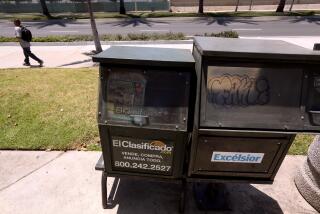High-Tech Publications Are Dropping Like Dot-Coms
- Share via
Time was, the dot-coms of the world were spending money on advertising like sailors on a binge. And newspapers were creating special sections focused on new technology, to chronicle the high-tech rage and rake in those advertising bucks.
Mike Phillips, the director of editorial development for the E.W. Scripps newspaper chain, recalls the heady time when high-tech advertising was like found money. “It was just wonderful,” he said. “And it was just vanity advertising. It didn’t do the dot-coms a bit of good.”
That, of course, has all changed.
Hundreds of dot-coms have gone south and are either struggling or dead. And those advertising dollars are gone too. Newspapers, in the grips of a terrible year in which ad lineage is down and newsprint prices are up, are doing some serious reassessing about the future of these sections.
Take, for instance, the Toronto Star, which closed down its high-tech section, Fast Forward, in July after a seven-year run. “Ironically,” wrote Fast Forward editor Robert Wright, “the section most identified with the dot-com boom has become victim of the dot-com bust.”
Or take the Houston Chronicle, one of the largest newspapers in the Southwest, which recently scuttled its high-tech section in the face of shrinking revenues, while at the same time making the strategic decision that technology articles should appear in all parts of the newspaper.
“Technology and technology coverage have become more mainstream,” said Scott Clark, the Chronicle’s assistant managing editor for business and technology. “The subject is a lot more mainstream now and not quite the niche it once was.”
Closer to home, the Orange County Register shut down its tech section, Connect, 18 months ago, well before the bust. “We just didn’t have what we felt we needed in revenue to make it worthwhile,” said Register spokeswoman Nancy Souza.
Then there is Access, the Needham, Mass.-based technology magazine that was inserted into 11 million Sunday papers each week before folding in June. The magazine, published by Access Media, was given away free to any newspaper willing to circulate it but simply could not sell enough ads to sustain itself.
The ills affecting newspapers are certainly in line with what is happening in the rest of the high-tech publication industry. Like the Industry Standard, a dot-com magazine that only a year ago was flying high on record profits. The magazine’s ad lineage has dropped by more than 70%, necessitating several rounds of layoffs that have cut the company staff by more than half--over 100 of them in January and February.
All this has created a certain wariness, even at newspapers in which these sections are entrenched.
“It creates an obvious concern in a down cycle like we’re in now that some of these sections might be revisited by editors,” said Mike Langberg, personal technology editor for the San Jose Mercury News, whose tech section has been around since 1983 and is considered the elder statesman of the genre. It too has suffered from the downturn, but Langberg said the section is not in jeopardy. The Los Angeles Times launched its Tech Times section in October and Business Editor Bill Sing said no major changes are anticipated.
That high-tech sections are vulnerable alarms James Naughton, the head of the Poynter Institute, a nonprofit center for journalism studies in St. Petersburg, Fla.
“I’m a techno junkie and I think there are a lot of others out there,” he said. “The daily newspaper is a smorgasbord of interests. If you stop having a kind of food in the smorgasbord, you may end up losing a certain kind of diner.”
Newspapers have been eliminating other foods from the smorgasbord as well within the last few years, such as stand-alone book review sections and Sunday magazines. Ken Bunting, the executive editor of the Seattle Post-Intelligencer, said that in the midst of the present economic crunch, unpopular decisions sometimes have to be made in the name of the bottom line.
“This is a tough year financially for the newspaper industry and newspapers have to do some priority-setting,” he said. “Technology may fall off quicker than the travel section.”
Andrew Nachison, director of the media center at the nonprofit American Press Institute, said it’s far too early to write the obituary of the high-tech sections. But he also said it is true that society has matured to a point where there is much less of a gee-whiz attitude when it comes to technology. “I think the rise of technology sections mirrored society’s new lust for technology,” he said. “Maybe that lust has subsided a little.”
Nachison said the status of tech sections raises the larger issue of what the newspaper is going to become in an era in which the river of information keeps widening.
“What is its role in a connected society where there is a much more massive flow of information than there used to be?” he asked. “Newspapers used to play a fairly significant role in the way Americans acquired general information about the world they lived in. They don’t play that same role anymore.”
Newspapers, he said, are often ignored, replaced by television, radio and Internet access to sites that offer everything from news headlines to local movie listings.
Nora Paul, director of the University of Minnesota Institute for New Media, pointed to the Everett (Wash.) Herald as a newspaper that used technology to engage its readers in participatory journalism.
In concert with a series of stories on the planned redevelopment of its waterfront, the paper produced a Web site where readers could propose the placement of such things as bike trails and an amphitheater, and then compiled the results. “It was sort of like Sim City,” she said, referring to the popular computer game.
On a more practical note, Langberg said he thought two other things were happening that are causing a sparseness in advertising. One is the gradual demise of the small computer stores that have been put out of business by the chains selling electronic equipment. The second is the inclination of the chains such as Best Buy and Fry’s to either use Sunday supplement inserts or place ads in different parts of the newspaper.
The result, he said, is a popular, well-read section that is lacking in ads. “There’s clearly reader interest and advertisers interested in reaching readers to sell these products,” he said. “But they are not connecting to each other.”
Wright, of the Toronto Star, said his paper started out with as many as six pages of local ads from “mom and pop stores,” but that number dwindled to less than a page by the time the section folded. “That’s your bread and butter and if you don’t have that, you’re in trouble,” he said.
Clark, of the Chronicle, contends that merging the tech section with business has made the latter more robust. The newspaper also groups all technology articles on its Web site, whose use is up 40% in that particular area. In June, 150,000 people used the high-tech Web page, Clark said.
Langberg, meanwhile, maintains that tech sections are viable because of what is on the horizon. “There’s going to be so much new technology coming out in the next 10 years,” he said. “The biggest problem for people is that they need a trusted third party to help them. I think people want newspapers to be a window into that world.”
Naughton, of the Poynter Institute, also pointed to the fact that most newspaper sports sections are not self-sustaining, either. “I live for Thursday when I can get the Wall Street Journal and New York Times [tech] sections,” he said. “I also think that if newspapers are trying to attract the next generation or two and they’re fretting about them not being attuned to the medium, it might not be bright to throw out a topic that young people connect to.”
More to Read
Inside the business of entertainment
The Wide Shot brings you news, analysis and insights on everything from streaming wars to production — and what it all means for the future.
You may occasionally receive promotional content from the Los Angeles Times.










